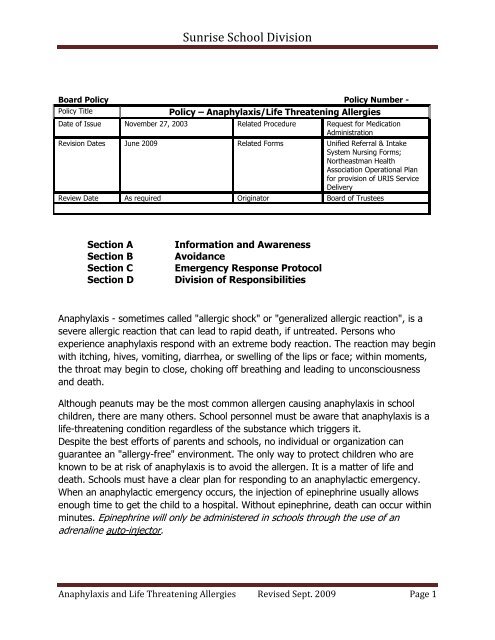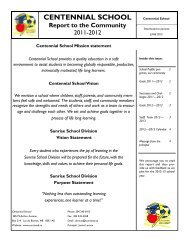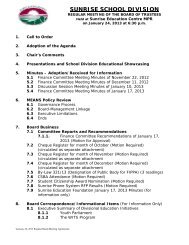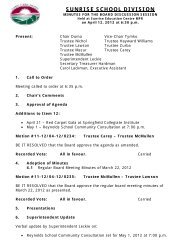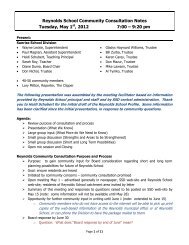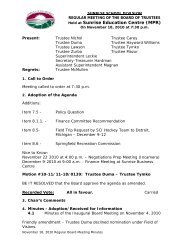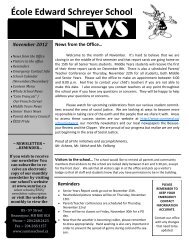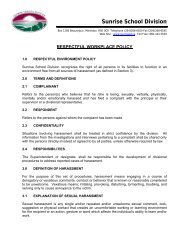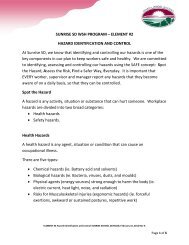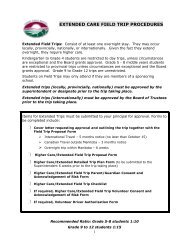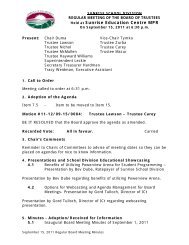Anaphylaxis Policy Revision - Sunrise School Division
Anaphylaxis Policy Revision - Sunrise School Division
Anaphylaxis Policy Revision - Sunrise School Division
You also want an ePaper? Increase the reach of your titles
YUMPU automatically turns print PDFs into web optimized ePapers that Google loves.
<strong>Sunrise</strong> <strong>School</strong> <strong>Division</strong>Board <strong>Policy</strong> <strong>Policy</strong> Number -<strong>Policy</strong> Title<strong>Policy</strong> – <strong>Anaphylaxis</strong>/Life Threatening AllergiesDate of Issue November 27, 2003 Related Procedure Request for MedicationAdministration<strong>Revision</strong> Dates June 2009 Related Forms Unified Referral & IntakeSystem Nursing Forms;Northeastman HealthAssociation Operational Planfor provision of URIS ServiceDeliveryReview Date As required Originator Board of TrusteesSection ASection BSection CSection DInformation and AwarenessAvoidanceEmergency Response Protocol<strong>Division</strong> of Responsibilities<strong>Anaphylaxis</strong> - sometimes called "allergic shock" or "generalized allergic reaction", is asevere allergic reaction that can lead to rapid death, if untreated. Persons whoexperience anaphylaxis respond with an extreme body reaction. The reaction may beginwith itching, hives, vomiting, diarrhea, or swelling of the lips or face; within moments,the throat may begin to close, choking off breathing and leading to unconsciousnessand death.Although peanuts may be the most common allergen causing anaphylaxis in schoolchildren, there are many others. <strong>School</strong> personnel must be aware that anaphylaxis is alife-threatening condition regardless of the substance which triggers it.Despite the best efforts of parents and schools, no individual or organization canguarantee an "allergy-free" environment. The only way to protect children who areknown to be at risk of anaphylaxis is to avoid the allergen. It is a matter of life anddeath. <strong>School</strong>s must have a clear plan for responding to an anaphylactic emergency.When an anaphylactic emergency occurs, the injection of epinephrine usually allowsenough time to get the child to a hospital. Without epinephrine, death can occur withinminutes. Epinephrine will only be administered in schools through the use of anadrenaline auto-injector.<strong>Anaphylaxis</strong> and Life Threatening Allergies Revised Sept. 2009 Page 1
<strong>Sunrise</strong> <strong>School</strong> <strong>Division</strong>A. Information and Awareness1. Identification of students who may urgently require medication/treatment to the<strong>School</strong> Administration and Staff• It is the responsibility of parents/guardian whose children may urgently requiremedication/treatment to identify their children to the school administrator bycompleting the health information section of their <strong>School</strong> Registration form whichincludes a section for parental/legal guardian authorization for a Health Care Planto be created.• Principal/Designate will collect the Health Care Information for each identified childand forward it to the URIS Clerk.• URIS Nurse accepts the URIS Group B Application and approves for support.• When URIS support is approved, the registered nurse shall review Group B HealthCare Procedures for each identified student in order to develop and maintain awritten Individual Health Care Plan (IHCP) and/or Emergency Response Plan(ERP) for each child requiring assistance by school personnel for Group B healthcare procedures. For children who are able to independently accomplish theirown Group B health care procedure, the registered nurse will develop a childspecific Emergency Response Plan (ERP). These plans are developed by theregistered nurse in consultation with parents, school personnel and, if required,by the physician.2. Identification of Students who may urgently require medication/treatment to Staff• All staff members shall be made aware that a child who may urgently requiremedication/treatment is attending their school, and the child shall be identified,either individually or at a staff meeting at the beginning of the school year.• All students identified as having a life threatening allergy shall have an "allergyalert" attached to their cumulative file. This "allergy alert" shall remain on thecumulative file throughout the student's attendance in <strong>Sunrise</strong> <strong>School</strong> <strong>Division</strong>.• The child's classroom teacher shall ensure that a copy of the Individual HealthCare Plan (IHCP) and/or Emergency Response Plan (ERP) is kept in a binderwhere it will be clearly marked, accessible and readily available to teachers.<strong>Anaphylaxis</strong> and Life Threatening Allergies Revised Sept. 2009 Page 2
<strong>Sunrise</strong> <strong>School</strong> <strong>Division</strong>• It is recommended that students wear a medic-alert bracelet which identifiesspecific medical information.• Medications shall be clearly marked with the student's name.3. In-service for Teachers and Other <strong>School</strong> Staff• The Administrator shall ensure that group training is provided by a health careprofessional (i.e. registered nurse/doctor/pharmacist) and that this trainingoccurs annually with school personnel, substitute teachers, bus drivers, lunchhour supervisors and volunteers, in schools where children with life threateningmedical conditions are enrolled.• All staff who may be in a position of responsibility for children with life threateningmedical conditions shall receive child-specific training related to the medicalcondition which is provided by a registered nurse.• Parents of the child with life threatening medical conditions shall ensure that thespecific information about their child is made available to school personnel to beincluded in training sessions. Parents are encouraged to attend/participate intraining sessions.4. Sharing Information with Other Students and Parents• In consultation with parents and student, the school may identify a student withlife threatening medical conditions to classmates who are in direct contact withthe child and enlist their understanding and support. This shall be done in a waythat is appropriate to the student’s age and maturity, without creating fear andanxiety.5. Maintaining Open Communication between Parents and the <strong>School</strong>• The school shall maintain open lines of communication with the parents ofstudents with life threatening medical conditions.• Parents shall be involved in establishing specific plans for their own children, andmay be involved in training staff in emergency procedures.<strong>Anaphylaxis</strong> and Life Threatening Allergies Revised Sept. 2009 Page 3
<strong>Sunrise</strong> <strong>School</strong> <strong>Division</strong>B. AvoidanceThe greatest risk of exposure to allergens is in new situations, or when normal dailyroutines are interrupted, such as birthday parties, camping, or school trips. Youngchildren are at greatest risk of accidental exposure, but many allergists believe thatmore deaths occur among teenagers due to their increased independence, peerpressure and a reluctance to carry medication.Avoidance of specific allergens is the cornerstone of management in preventinganaphylaxis. All of the following strategies shall be considered in the context of thestudent's age and maturity as well as the organization and physical layout of the schooland the properties of the allergen(s). As students mature, they shall be expected totake increasing personal responsibility for avoidance of their specific allergen(s).1. Establishing Safe Lunchroom and Eating Area ProceduresStudents with life threatening allergies are dependent upon the school community tominimize the presence of substances to which the student is allergic.• Strongly encourage students with life threatening allergies to eat only foodprepared from home.• Discourage the sharing of food, utensils and containers.• Encourage the child with life threatening allergies to take the followingprecautions such as:- placing food on wax paper or a paper napkin rather than directly on the desk ortable- taking only one item at a time from the lunch bag to prevent crosscontamination.• Establish a hand-washing routine before and after eating.• Recommend that tables and other eating surfaces are washed clean after eating,using a cleansing agent approved for school use. This is particularly importantfor students with peanut allergies because of the adhesive nature of peanutbutter.2. Allergens Hidden in <strong>School</strong> ActivitiesNot all allergic reactions are a result of exposure at meal times.<strong>Anaphylaxis</strong> and Life Threatening Allergies Revised Sept. 2009 Page 4
<strong>Sunrise</strong> <strong>School</strong> <strong>Division</strong>Children with life threatening allergies may be at risk if involved in garbage disposal,recycling, yard clean-ups, or other activities which could bring them into contact withfood wrappers, containers or debris.• Teachers shall choose products which are safe for all children in the classroom.• Teachers, particularly in the primary grades, shall be aware of the possibleallergens present in curricular materials such as:- craft materials (playdough, egg cartons, etc.) pets and pet food- bean-bags, stuffed toys (peanut shells are sometimes used) counting aids(beans, peas)- toys, books and other items which may have become contaminated in thecourse of normal useScience projects, participation in Home Economics special seasonal activities(Easter eggs and garden projects).• Allow the child with life threatening allergies to keep the same locker and desk allyear in order to help prevent accidental contamination, as foods are often storedin lockers and desks.3. Holidays and Special CelebrationsFood is often associated with special occasions and events. The following procedureswill help to protect the child with life threatening allergies:• Require the child with life threatening allergies to eat food brought from hisor her own home.• Focus on activities rather than food to celebrate special occasions.4. Field Trips/ExcursionsIn addition to the usual school safety precautions applying to field trips, the followingprocedures shall be in place to protect the child with life threatening allergies:• Require all staff and volunteers to be aware of the identity of the child with lifethreatening allergies, the allergens, symptoms and treatment.• Ensure that a staff member with training in the use of the Auto-injector isassigned responsibility for the child with life threatening allergies. A copy of theIndividual Health Care Plan (IHCP) and Emergency Response Plan (ERP) shall becarried by the person responsible for administration of the auto-injector.<strong>Anaphylaxis</strong> and Life Threatening Allergies Revised Sept. 2009 Page 5
<strong>Sunrise</strong> <strong>School</strong> <strong>Division</strong>• If the risk factors are too great to control, the child with life threatening allergiesmay be unable to participate in the field trip. Parents shall be involved in thisdecision.• Teachers/Administrators shall ensure that emergency response plans are in placewhen planning the trip.• There shall be reasonable and appropriate access to a telephone, cellulartelephone, or radio communication during an excursion.5. <strong>Anaphylaxis</strong> to Insect VenomAvoidance is more difficult to achieve for this type of allergy, but certain precautions bythe schools may be helpful:• Request removal of insect nests from school property by calling theMaintenance Manager for northern schools at 268-6528.• Allow students with life threatening allergies to insect stings to remain indoorsfor recess during bee/wasp season.• Immediately remove a child with an allergy to insect venom from the room if abee or wasp enters.• During wasp season (August to October approximately) students should refrainfrom bringing food and drinks outdoors.• Ensure proper storage of garbage in well-covered containers.C. Emergency Response ProtocolEven when precautions are taken, a student with life threatening allergies may comeinto contact with an allergen while at school. A separate emergency plan shall bedeveloped for each child with life threatening allergies, in conjunction with the child'sparents and registered nurse, and kept in a readily accessible location.1. Emergency PlansEpinephrine is the treatment for an anaphylactic reaction. There are no contradictionsto the use of epinephrine for a life threatening allergic reaction. Epinephrine must beadministered as early as possible after the onset of symptoms of severe allergicresponse.<strong>Anaphylaxis</strong> and Life Threatening Allergies Revised Sept. 2009 Page 6
<strong>Sunrise</strong> <strong>School</strong> <strong>Division</strong>• The emergency plan includes the following:- communicate the emergency to a staff person who is trained in the use ofthe Auto-injector- administer the Auto-injector (NOTE: Although most children with lifethreatening allergies learn to administer their own medication by aboutage 8, individuals of any age may require help during a reaction becauseof the rapid progression of symptoms, or because of the stress of thesituation. (Adult supervision is required.)- call 911 and inform the emergency operator that a child is having ananaphylactic reaction- transport the child to hospital at once by ambulance- provide a copy of the Individual Health Care Plan (IHCP) and/or EmergencyResponse Plan (ERP) (as well as the used Auto-injector to the ambulanceattendants)- telephone the parents of the child- implement Procedures of Routine Practices as appropriate.Note: *All hazardous materials should be stored in a special container and disposed ofaccordingly.2. Location of Auto-injectors• Students shall carry their own auto-injectors on their person at all times withinstructions for use.• Where a question arises regarding the urgency of medication or the capability ofa student, the registered nurse in consultation with parent/guardian, physician,and school personnel shall develop an appropriate plan.• Parents have the option of supplying an extra auto-injector to be kept in theschool office for emergency situations. An optional back up auto-injector shallbe kept in a covered and secure area, but unlocked for quick access.3. Review Process<strong>School</strong> emergency response and general health care procedures for each student withlife threatening allergies shall be reviewed annually at the beginning of September withstaff and parents. High schools need to provide information to staff before eachsemester. In the event of an emergency response, an immediate evaluation of theprocedure shall be undertaken.<strong>Anaphylaxis</strong> and Life Threatening Allergies Revised Sept. 2009 Page 7
<strong>Sunrise</strong> <strong>School</strong> <strong>Division</strong>D. <strong>Division</strong> of ResponsibilitiesEnsuring the safety of children with life threatening allergies in a school setting dependsupon the understanding and support of the entire school community. To minimize riskof exposure, and to ensure rapid response to emergency, parents, students and schoolpersonnel must all understand and fulfill their responsibilities.1. Responsibilities of the Parents/Legal Guardians of a Child with Life ThreateningAllergies• Inform the school of their child's allergies.• Provide the school with physician's instructions for administering medication bycompleting the Health Care Information section of the <strong>School</strong> Registrationform.• Sign the Authorization for the development of a Health Care Plan• Provide the child with a clearly labelled current (up-to-date) Adrenaline autoinjector(s)and keep current.• Provide support to school and teachers as required.• If possible and appropriate, supply information for school publications including:- items to avoid that may contain allergens- resources• Provide safe foods for special occasions.• Teach their child:- to recognize the first symptoms of an anaphylactic reaction- to communicate clearly when he or she feels a reaction starting tocarry his/her own auto-injector.- not to share snacks, lunches or drinks- to understand the importance of hand-washing- to cope with teasing and being left out to report bullyingand threats to an adult in authority- to take as much responsibility as possible for his/her ownsafety.Consider a medic alert bracelet for their child.2. Responsibilities of the Supervisor of Transportation• To ensure that all bus drivers are trained on the use of an adrenaline autoinjector.<strong>Anaphylaxis</strong> and Life Threatening Allergies Revised Sept. 2009 Page 8
<strong>Sunrise</strong> <strong>School</strong> <strong>Division</strong>• To ensure that a child with life threatening allergies has an individualtransportation plan which includes the process for dealing with a potentialanaphylactic reaction on a school bus.3. Responsibilities of the Administrator• Assist with the development and implementation of policies and procedures forreducing risk in classrooms and common areas.• Work as closely as possible with the parents of a child with life threateningallergies.• Inform students about the nature of anaphylaxis at a student assembly.• Ensure that the parents have completed Authorization for the development of aHealth Care Plan.• Notify the staff of the child with life threatening allergies, their allergens and theavoidance and treatment strategies.• Post allergy-alert information including a photo-poster that identifies eachstudent in the staff room and/or office• Maintain up-to-date emergency contacts and telephone numbers (suggestions:red/orange sticker)• Cumulative file is to contain the most current phone numbers.• Establish a current list of public health nursing personnel for the school.• Ensure that the "allergy alert" is attached to the cumulative file• Ensure that all staff and, where appropriate, lunch hour supervisors, bus drivers,and volunteers have received training related to life threatening allergies.• Notify parents that training has been completed.• Ensure that all substitute teachers are informed of the presence of a child withlife threatening allergies and that appropriate support/response is available shouldan emergency occur.• Discuss with parent/child the option of informing other parents that a child withlife threatening allergies has direct contact with their child and ask for theirsupport and cooperation.• Establish safe procedures for field trips and extra-curricular activities.• Develop a school plan for reducing risk in classrooms and common areas.Consult members of the Student Support Services Team at each school, fordealing with issues involving bullying and threats.3. Responsibilities of the URIS Nurse• Request and compile all Group B URIS Application and Authorization for theRelease of Medical Information form from all schools.<strong>Anaphylaxis</strong> and Life Threatening Allergies Revised Sept. 2009 Page 9
<strong>Sunrise</strong> <strong>School</strong> <strong>Division</strong>• Train and monitor personnel involved with child with life threatening allergies,develop Individual Health Care Plan (IHCP) and/or Emergency Response Plan(ERP) on an annual basis.4. Responsibilities of the Classroom Teacher• Leave information in an organized, prominent and accessible format forsubstitute teachers.• With permission of parent/legal guardian, display a photo-poster in the staffroomand office and in substitute’s binder in the classroom.• Discuss anaphylaxis with the class, in age-appropriate terms.• Encourage students not to share lunches or trade snacks.• Choose products which are safe for all children in the class.• Encourage children with life threatening allergies to eat only what he/she bringsfrom home.• Reinforce hand washing before and after eating.• Where appropriate, facilitate communication with other parents.• Follow the <strong>Sunrise</strong> <strong>School</strong> <strong>Division</strong> <strong>Anaphylaxis</strong> <strong>Policy</strong> for reducing risk ofexposure to allergens.• Consult with members of the Student Support Services Team at each schoolregarding issues of bullying and threats• Ensure that auto-injectors are taken on field trips and emergency response plansare in place when planning the trip.• Consult with parents when planning activities such as field trips, art and homeeconomics projects in order that alternate plans can be developed if necessary.5. Responsibilities of the Registered Nurse• Review URIS Group B Application forms which identify children with lifethreatening allergies after URIS approval has been received.• Consult with and provide information to parents, students, school personnel andSupervisor of Transportation.• Develop an Individual Health Care Plan (IHCP) and/or an Emergency ResponsePlan (ERP) for the child with known risk of anaphylaxis.• Provide child specific training and ongoing monitoring to personnel involved withchildren with known risk of anaphylaxis.<strong>Anaphylaxis</strong> and Life Threatening Allergies Revised Sept. 2009 Page 10
<strong>Sunrise</strong> <strong>School</strong> <strong>Division</strong>7. Responsibilities of the Student with Life threatening Allergy• Take as much responsibility as possible for avoiding allergens, including checkinglabels and monitoring intake as developmentally appropriate.• Eat foods brought from home.• Wash hands before and after eating.• Learn to recognize symptoms of an anaphylactic reaction as developmentallyappropriate.• Promptly inform an adult, as soon as accidental exposure occurs or symptomsappear.• Keep an auto-injector on his/her person at all times (fanny pack).• Know how to use the auto-injector as developmentally appropriate.8. Responsibilities of All Parents• Support requests from school to eliminate allergens from packed lunches andsnacks and, if appropriate, participate in parent information sessions.• Encourage children to respect the needs of children with life threatening allergiesand <strong>Sunrise</strong> <strong>School</strong> <strong>Division</strong> <strong>Anaphylaxis</strong> <strong>Policy</strong>.• Inform the teacher prior to distribution of food products to any children in theschool.9. Responsibilities of All Children in the Class• Avoid sharing food, especially with children with known risk of anaphylaxis,• Follow school rules about keeping allergens out of the classroom and washinghands.• Refrain from bullying or teasing a child with a known risk of anaphylaxis.<strong>Anaphylaxis</strong> and Life Threatening Allergies Revised Sept. 2009 Page 11
<strong>Sunrise</strong> <strong>School</strong> <strong>Division</strong>APPENDIX OF FORMS1. <strong>Sunrise</strong> <strong>School</strong> <strong>Division</strong> Health Care Information Registration Insert2. Unified Referral & Intake System (URIS) Group B Application3. <strong>Anaphylaxis</strong> Health Care Plan4. Handwashing Protocol5. Procedures of Routine Practice<strong>Anaphylaxis</strong> and Life Threatening Allergies Revised Sept. 2009 Page 12
<strong>Sunrise</strong> <strong>School</strong> <strong>Division</strong>SUNRISE SCHOOL DIVISIONHEALTH CARE INFORMATIONSTUDENT’S NAME: ________________________________________SCHOOL: _________________________________________________This form is to be used when a student registers andmay be used if a student requires a U.R.I.S.* Application1. a) Does your child have any allergies? _____ If yes, please list specific allergies.______________________________________________________________________________________________________________________________b) Does your child have an Epi-Pen for allergies? _______ Please note: If yes, your childmust wear the Epi-Pen at all times.2. Does your child take medication for asthma (including inhalers)? ________________ If yes,how often? _________________________________3. Will your child need to take medication at school? _____ If yes, please explain what it is andhow often?_________________________________________________________________4. Does your child take medication at home? _____ If yes, what it is and how often?___________________________________________________________________________________________________________________________________5. Does your child have seizures? _____ If yes, when was the last seizure? _______6. Does your child have any other health concerns we need to be aware of? (e.g. diabetes,migraines, heart condition, etc.)_____________________________________________________________________________________________________________________________________If your child has health care issues, which require a Health Care Plan, your child’sschool will request your authorization.I agree that a Health Care Plan can be created for _________________.Parent/Legal Guardian Signature: _________________Date: ______________http://www2.sunrisesd.ca/school/studentsupport/Procedures/Forms/Documents/<strong>Anaphylaxis</strong> <strong>Policy</strong> <strong>Revision</strong>.docx
<strong>Sunrise</strong> <strong>School</strong> <strong>Division</strong>Please note the actual two page double-sided form should be downloaded separately – this isONLY a sample of the information for your reference.Unified Referral and Intake System (URIS) Group B ApplicationIn accordance with Section 15 of The Personal Health Information Act (PHIA), the purpose of thisform is to identify the child’s health care intervention(s) and apply for URIS Group B support whichincludes the development of a health care plan and training of community program staff by aregistered nurse. If you have questions about the information requested on this form, you maycontact the community program.Section I – Community program information (to be completed by the community program)Type of community Name of community program:program (please √) Contact person: <strong>School</strong>Phone:Fax: Licensed child care RespiteEmail: Recreation program Address (location where service is to be delivered):Street:City/Town:POSTAL CODE:Section II - Child informationLast Name First Name BirthdateAlso Known Asmonth (print) D D Y Y Y YPlease check (√) all health care conditions for which the child requires an intervention during attendance atthe community program. Life-threatening allergy (and child is prescribed an EpiPen)Does the child bring an EpiPen to the community program? YES NO Asthma (administration of medication by inhalation)Does the child bring asthma medication (puffer) to the community program? YES NOCan the child take the asthma medication (puffer) on his/her own? YES NO Seizure disorderWhat type of seizure(s) does the child have?Does the child require administration of rescue medication (e.g., sublingual lorazepam)? YES NOhttp://www2.sunrisesd.ca/school/studentsupport/Procedures/Forms/Documents/<strong>Anaphylaxis</strong> <strong>Policy</strong> <strong>Revision</strong>.docx
<strong>Sunrise</strong> <strong>School</strong> <strong>Division</strong> DiabetesWhat type of diabetes does the child have? Type 1Type 2Does the child require blood glucose monitoring at the community program? YES NODoes the child require assistance with blood glucose monitoring? YES NODoes the child have low blood sugar emergencies that require a response? YES NO Cardiac condition where the child requires a specialized emergency response at the communityprogram.What type of cardiac condition has the child been diagnosed with? Bleeding Disorder (e.g., von Willebrand disease, hemophilia)What type of bleeding disorder has the child been diagnosed with? Steroid Dependence (e.g., congenital adrenal hyperplasia, hypopituitarism, Addison’s disease)What type of steroid dependence has the child been diagnosed with? Osteogenesis Imperfecta (brittle bone disease) Gastrostomy Feeding CareDoes the child require gastrostomy tube feeding at the community program? YES NODoes the child require administration of medication via the gastrostomy tubeat the community program? YES NO Ostomy CareDoes the child require the ostomy pouch to be emptied at the community program? YES NODoes the child require the established appliance to be changedat the community program? YES NODoes the child require assistance with ostomy care at the community program? YES NO Clean Intermittent Catheterization (IMC)Does the child require assistance with IMC at the community program? YES NO Pre-set OxygenDoes the child require pre-set oxygen at the community program? YES NODoes the child bring oxygen equipment to the community program? YES NO Suctioning (oral and/or nasal)Does the child require oral and/or nasal suctioning at the community program? YES NODoes the child bring suctioning equipment to the community program? YES NOSection III - Authorization for the Release of Medical Informationhttp://www2.sunrisesd.ca/school/studentsupport/Procedures/Forms/Documents/<strong>Anaphylaxis</strong> <strong>Policy</strong> <strong>Revision</strong>.docx
<strong>Sunrise</strong> <strong>School</strong> <strong>Division</strong>I authorize the Community Program, the Unified Referral and Intake System Provincial Office, and the nursing provider serving thecommunity program, all of whom may be providing services and/or supports to my child, to exchange and release medical informationspecific to the health care interventions identified above and consult with my child’s physician(s), if necessary, for the purpose ofdeveloping and implementing an Individual Health Care Plan/Emergency Response Plan and training community program staff for_____________________________________.(child’s name)I also authorize the Unified Referral and Intake System Provincial Office to include my child’s information in a provincial databasewhich will only be used for the purposes of program planning, service coordination and service delivery. This database may beupdated to reflect changing needs and services. I understand that my child’s personal and personal health information will be keptconfidential and protected in accordance with The Freedom of Information and Protection of Privacy Act (FIPPA) and The PersonalHealth Information Act (PHIA).I understand that any other collection, use or disclosure of personal information or personal health information about my child will notbe permitted without my consent, unless authorized under FIPPA or PHIA.Consent will be reviewed with me annually. I understand that as the parent/legal guardian I may amend or revoke this consent atany time with a written request to the community program.If I have any questions about the use of the information provided on this form, I may contact the community program directly.________________________________________Parent/Legal guardian signature______________________Date_____________________________________________ ________________ ________________________Mailing Address Postal Code Phone numberPlease note the actual two page double-sided form should be downloaded separately – this isONLY a sample of the information for your reference.http://www2.sunrisesd.ca/school/studentsupport/Procedures/Forms/Documents/<strong>Anaphylaxis</strong> <strong>Policy</strong> <strong>Revision</strong>.docx
<strong>Sunrise</strong> <strong>School</strong> <strong>Division</strong>Student:Date:<strong>School</strong>:Address:DOB:MHSC:PHIN:Parent Information#1 Home #:Work #:#2 Home #:Work #:Alternate Emergency Contact:#1 Phone #:Physician:Dr: Phone #:Health Care Needs (Diagnosis)ANAPHYLAXIS reaction to:IHCP developed by:________________________Date:_______________Edna Aytona-Austman, R.N. (U.R.I.S. Nurse) Phone #: 268-6518Receivedby:______________________________Date:________________(Principal’s Signature)Parent/Guardian:__________________________Date:______________(Signature)ANAPHYLAXIS HEALTH CARE PLANhttp://www2.sunrisesd.ca/school/studentsupport/Procedures/Forms/Documents/<strong>Anaphylaxis</strong> <strong>Policy</strong> <strong>Revision</strong>.docx
<strong>Sunrise</strong> <strong>School</strong> <strong>Division</strong>Life threatening allergy to:Child’s “usual” reaction to allergen:Type of auto injector and size:EpiPen® size: Regular 0.3 mg ________ Junior 0.15 mg ____________Twinject size: Adult 0.3 mg _________ Child 0.15 mg _____________PLEASE NOTE:Only the first injection of the Twin-ject will be taught at thecommunity level. The second injection is considered a Group Aprocedure and cannot be taught at the community level.Auto-injector location:(It is recommended that the auto-injector be located with the child,not in a locked location). fanny packother:____________________________________________________________________location of backup Epi-Pen:__________________________________________________Medic Alert worn:YesNohttp://www2.sunrisesd.ca/school/studentsupport/Procedures/Forms/Documents/<strong>Anaphylaxis</strong> <strong>Policy</strong> <strong>Revision</strong>.docx
<strong>Sunrise</strong> <strong>School</strong> <strong>Division</strong>ANAPHYLAXIS EMERGENCY RESPONSE PLANChild’s Name:IF YOU SEE THIS:If ANY combination of the followingsigns occurs and there is reason tosuspect anaphylaxisThroat tightness or closingChange in voiceDifficulty swallowingDifficulty breathingCoughingWheezingChange in skin colorDizzinessRunny noseRed watery eyesHivesItchingSwellingVomitingDiarrheaStomach crampsSense of doomChange in behaviorFainting or loss of consciousnessBirth date:DO THIS:1. Give adrenaline auto-injector.2. Activate 911/EMS.3. Contact the child’sparent/guardian.4. If signs of anaphylaxis persist orrecur, give second dose (ifavailable) every 10-15 minutes.5. Stay with the child. Providerelevant information to EMSpersonnel.Signs of anaphylaxis seenWhen signs were first observed(time)When auto-injector was givenWhere auto-injector was givenEffect of auto-injector on childAuto-injector: To be carried on person at all times Store in protective chamber at room temperature Avoid extreme heat, cold and sunlight Parent/Guardian to replace prior to expiration date.http://www2.sunrisesd.ca/school/studentsupport/Procedures/Forms/Documents/<strong>Anaphylaxis</strong> <strong>Policy</strong> <strong>Revision</strong>.docx
<strong>Sunrise</strong> <strong>School</strong> <strong>Division</strong>Appendix A-4Handwashing for Staff1. Use soap and warm running water.2. Wet your hands and add soap.3. Rub your hands vigorously for 5 to 10 seconds.4. Wash all surfaces, including the backs of hands and between fingers.5. Rinse your hands well under running water for 5 to 10 seconds.6. Dry your hands well with a towel. Turn off the taps with a single-use towel.7. Dispose of the cloth or paper towel.8. Apply hand lotion, as needed.Washing your hands is the single most effective way of reducing thespread of infection.http://www2.sunrisesd.ca/school/studentsupport/Procedures/Forms/Documents/<strong>Anaphylaxis</strong> <strong>Policy</strong> <strong>Revision</strong>.docxAppendix A-5
<strong>Sunrise</strong> <strong>School</strong> <strong>Division</strong>Procedures of Routine Practice(formerly Universal Precautions)Barrier MethodsWear disposables gloves when you encounter blood or blood-stained body fluid, especially ifyou have open cuts or chapped hands.Wash your hands with soap and water for 30 seconds after contact with blood or body fluidscontaining blood.Cover cuts or scratches with a bandage until they are healed.Use disposable absorbent material like paper towels to stop bleeding.Wash your hands as soon as you remove your gloves and never reuse them.Cleaning and DisinfectingImmediately clean up blood spills using disposables, absorbent material. Wear disposablesgloves.Wash with hot soapy water and disinfect with a solution of one part bleach to 9 parts water(1:9).DisposalDiscard blood-stained material in a sealed plastic bag and place in a lined, covered garbagecontainer.Put blood-stained clothes in a sealed plastic bag. Machine wash separately in hot soapywater.Wash hands thoroughly afterwards.http://www2.sunrisesd.ca/school/studentsupport/Procedures/Forms/Documents/<strong>Anaphylaxis</strong> <strong>Policy</strong> <strong>Revision</strong>.docx


